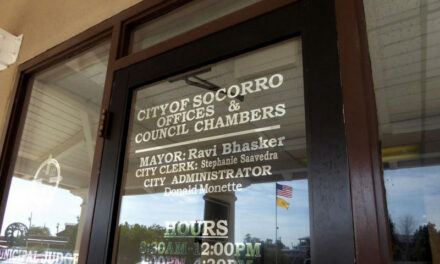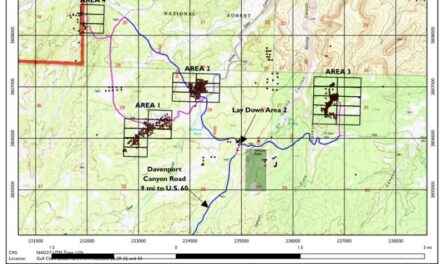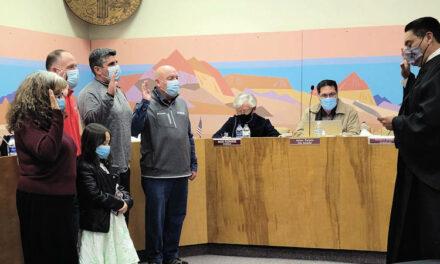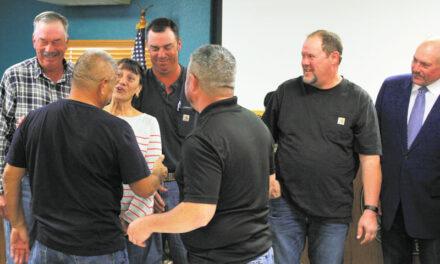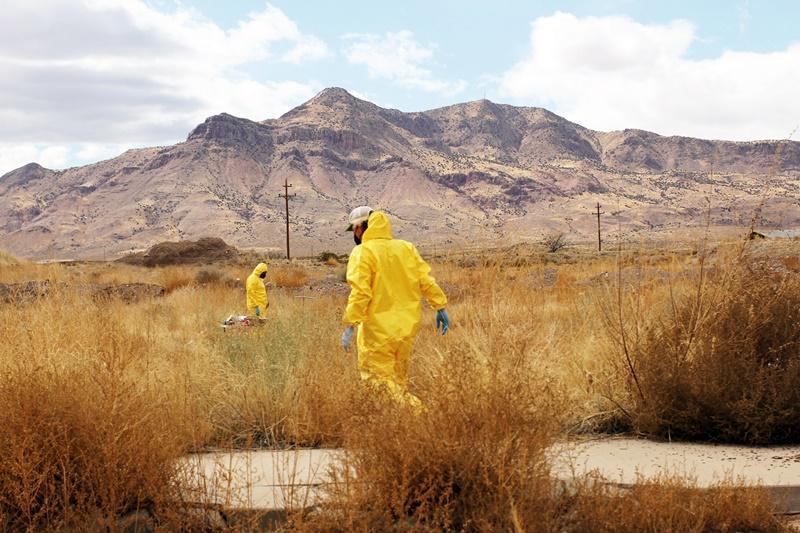
Two Interra employees take soil samples at Eagle Picher Superfund site. After years of community advocacy, the site is
set to receive $19 million in federals funds to clean it up.
Cathy Cook | El Defensor Chieftain photos
After years of community advocacy, the Eagle Picher Battery Superfund site is set to receive $19 million in federal funds to clean it up, with the money split into $3 million for soil excavation and building demolition, and $16 million for a pump-and-treat remedy for the contaminated groundwater.
The New Mexico Environment Department will be contracting the cleanup work and using some local labor.
Earthea Nance, regional administrator for the Environment Protection Agency, visited Socorro this week to announce the appropriation. She praised the collaboration between local, state and federal government, and the bipartisan support for funding the project. Sen. Martin Heinrich, D-N.M., in a letter read aloud, and Sen. Ben Ray Luján, D-N.M., in a video message, praised the funding.
“I know this community has been waiting a long time, 14 years,” Nance said. “Thanks to President Biden’s bipartisan infrastructure law and the work of Congress, Eagle Picher is one of the previously unfunded Superfund sites that will receive infrastructure money to jump-start the cleanup.”
A total of $3.5 billion is being invested in remediation efforts for Superfund sites across the country and the law reinstates chemical excise taxes to help pay for it. The Socorro site is one of 49 previously unfunded high-priority sites that will receive money. The McGaffey and Main Street Groundwater Plume in Roswell is another of the sites that will benefit.
“This funding will make a dramatic difference in the EPA’s ability to clean up Superfund sites faster and more efficiently,” Nance said.

Two Interra employees don safety gear before taking soil samples at the Eagle Picher Superfund site in February.
Approximately 60% of the sites getting new funding are located in historically underserved communities.
“More than one in four Black and Hispanic Americans live within three miles of a Superfund site,” she said. “This is unacceptable and we are working to correct this inequity.”
The Eagle Picher site was formerly the location of a battery factory and, much earlier, home to a tuberculosis sanatorium. Eagle Picher made printed circuit boards from 1964 to 1976, dumping industrial waste in unlined lagoons at the site. From 1980 to 1989, the company made lead-acid batteries and dumped more industrial waste into the lagoons. In 2007, it became a Superfund site and was listed on the National Priorities List.
In a bankruptcy settlement, the Eagle Picher company paid $4 million to the EPA, which the agency and the state Environmental Department used for feasibility studies and to design a remediation plan. It was not nearly enough to clean up the pollutants, which include TRC (trichloroethylene), lead and asbestos.
The soil excavation can begin quickly and may be complete within two to three years, said Supervisory Environmental Engineer Blake Atkins. Spots in the soil with elevated levels of lead and other metals will be excavated and backfilled with other soil. Remediation for asbestos and lead paint will also be done on existing structures.
Treating the groundwater contamination will take much longer. The EPA already has a design to pump, treat and reinject water, which it may pursue. However, that approach requires a lot of expense and maintenance, so they are examining other options to make sure they choose the best treatment for the water.
“We want to have a really good characterization of the site so that the design of the remedy, everyone can feel confident in that,” Nance said.
New Mexico Environment Secretary James Kenney said he knows there is pain, frustration and stigma that comes with having a Superfund site within a community. Cleaning up Eagle Picher is an opportunity to flip the switch on that stigma.
Kenney also said that holding polluters accountable is crucial because there is already too much legacy pollution in the state.
“We need strong rules. We need robust enforcement of those rules and we have to realize that waiting for $19 million, sometimes that doesn’t happen, and we need to prevent as much pollution as we’re mitigating pollution in an area like this today,” he said.
Kenney suggested the cleanup site could be used as a working lab in collaboration with New Mexico Tech, giving engineering students hands-on experience, an idea he plans to propose to the university’s president.
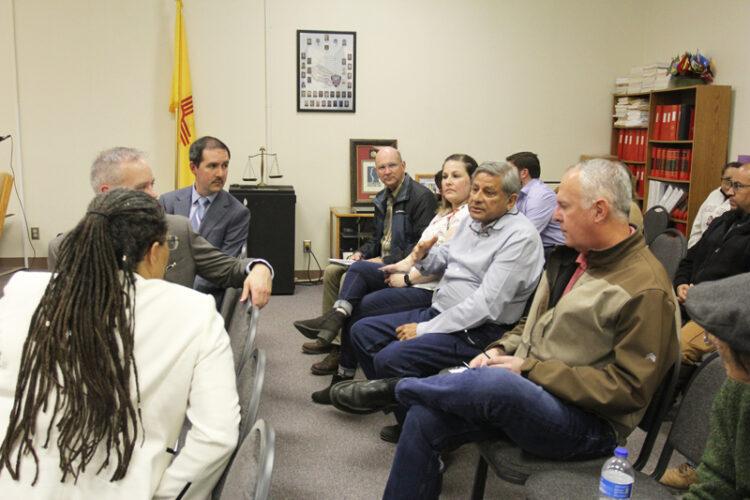
Socorro Mayor Ravi Bhasker asks EPA and NMED officials about the Eagle Picher cleanup plans during a press conference and community meeting.
Nance commended Bhasker for following the progress of the project.
“You have been actively involved in addressing lead contamination from lead acid batteries and your city has continued for many years to advocate for clean up,” she said. “This is a resilient and self-advocating community, invested in seeing its residents grow and thrive. Big cleanups like this take years, but Socorro has kept up the pressure for action.”
Atkins said he felt the meeting fulfilled its purpose.
“The meeting went quite well in my opinion,” Atkins said. “We had a good dialog with our new Regional Administrator, Secretary Kenney, Mayor Bhasker, and other congressional staff, and several community members. We’re all looking forward to getting this project started.”
Rebe Feraldi, who chairs the Community Advisory Group, had hoped more community members had shown up for the meeting, and says the voice of the public is as important as ever to facilitate getting information from the EPA and then from the community back to the EPA.
“They still need information from the public,” Feraldi said. “There are standard procedures for the TCE and PCE but the one for dioxin requires this other process. They say they are examining other options to make sure they choose the best treatment. How much of the money is going to be spent on this additional characterization?
“The public, I think, wants to know what the actions are going to take to further the process,” Feraldi said. “And will they accept potential alternative plans from the wealth of expertise that’s in Socorro, which is, I think, CAG is the liaison for.”
She also thinks using local labor is important.
“We just want to get as much information to the community and as much information from the community, which is the whole purpose of the CAG,” Feraldi said. “We have a lot of resources in the community and I just want to make sure that they’re utilized, involved, and that this money doesn’t get used up in routine blue-tape, red-tape kind of processes, and be used more efficiently. Because this community can handle it.”
The next meeting of the Community Advisory Group will be Thursday, Apr. 14, at 6:30 p.m. at the Socorro Public Library. More information and links can be found on the group’s Facebook page, Socorro NM Eagle Picher Superfund site.





